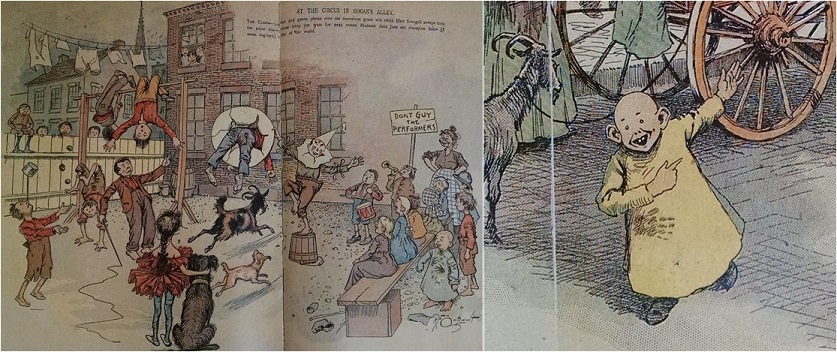Richard Felton Outcault (1863 – 1928) was an illustrator and cartoonist. He started as a scientific illustrator who worked for Thomas Edison but he is best known for his series “The Yellow Kid” which was centered around an Irish boy named Mickey Dugan living in the immigrant neighborhoods of New York’s Lower East Side. The Yellow Kid was so-named because he always appeared in a yellow shirt, he was often bare footed and sometimes pulling around a dead cat on a string.
It’s hard to overstate the significance of The Yellow Kid series. It was hugely popular at the time and became a cultural icon. The Yellow Kid has been recognized as the first American comic strip and has been honoured by the United States Postal Service. Outcault originally created the series for Joseph Pulitzer‘s New York World and in the newspaper wars of the turn of the century New York he was subsequently hired away by William Randolph Hearst‘s New York Journal.
Outcault created a fictional place in Mickey Dugan’s world name “Hogan’s Alley” where he and his pals played. Hogan’s Alley was a chaotic, messy, disorganized and playful lane where all sorts of mischief took place. Above are illustrated “At The Circus In Hogan’s Alley” dated May 5, 1895 (New York World) and a detail from “Moving Day In Hogan’s Alley” from May 3, 1896 (New York World).
Due to the popularity of The Yellow Kid, the term “Hogan’s Alley” became synonymous with poor especially immigrant neighborhoods with much and sometimes nefarious activity. There were many neighborhoods referred to informally as “Hogan’s Alley” throughout North America and it was as such that the T-shaped lane in Vancouver bordered by Union Street, Prior Street, Gore Avenue and Main Street, which is two blocks west of 823 Jackson Avenue, came to be known. The north-south portion of this lane was also named Park Lane. Some have referred to Hogan’s Alley as extending east along the lane between Union and Prior and some have also referred generally to the area as Hogan’s Alley.
In 1970 the block containing Hogan’s Alley was demolished in order for the ramps to the Georgia and Dunsmuir viaducts to be built and the rest of the block is now a park.

